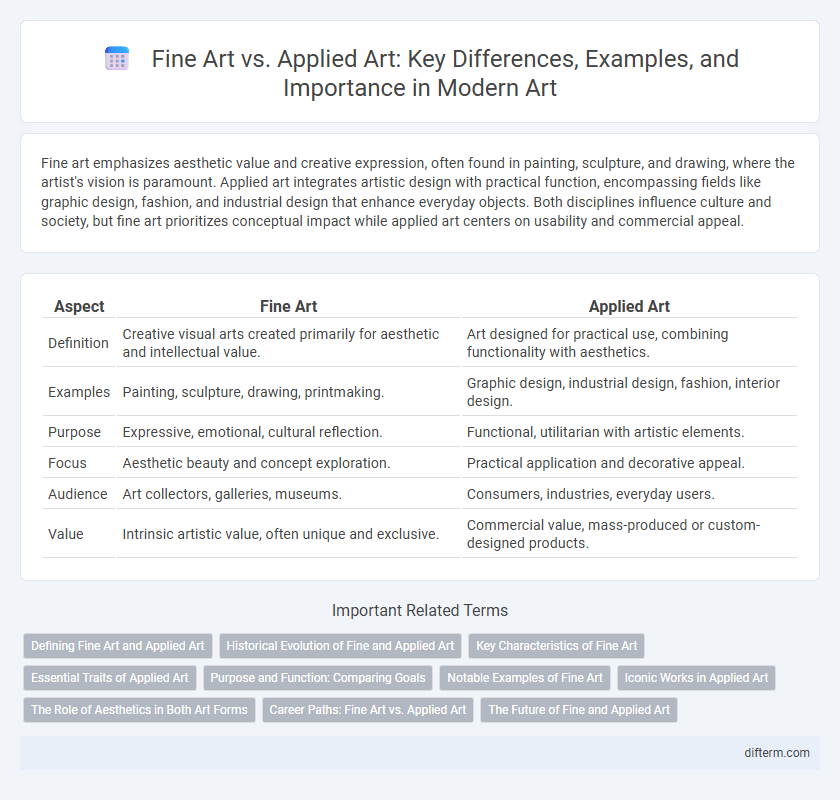Fine art emphasizes aesthetic value and creative expression, often found in painting, sculpture, and drawing, where the artist's vision is paramount. Applied art integrates artistic design with practical function, encompassing fields like graphic design, fashion, and industrial design that enhance everyday objects. Both disciplines influence culture and society, but fine art prioritizes conceptual impact while applied art centers on usability and commercial appeal.
Table of Comparison
| Aspect | Fine Art | Applied Art |
|---|---|---|
| Definition | Creative visual arts created primarily for aesthetic and intellectual value. | Art designed for practical use, combining functionality with aesthetics. |
| Examples | Painting, sculpture, drawing, printmaking. | Graphic design, industrial design, fashion, interior design. |
| Purpose | Expressive, emotional, cultural reflection. | Functional, utilitarian with artistic elements. |
| Focus | Aesthetic beauty and concept exploration. | Practical application and decorative appeal. |
| Audience | Art collectors, galleries, museums. | Consumers, industries, everyday users. |
| Value | Intrinsic artistic value, often unique and exclusive. | Commercial value, mass-produced or custom-designed products. |
Defining Fine Art and Applied Art
Fine art encompasses creative works such as painting, sculpture, and drawing, valued primarily for their aesthetic and intellectual qualities rather than practical function. Applied art integrates artistic design with functional objects like furniture, textiles, and graphic design, emphasizing both utility and visual appeal. Understanding the distinction between fine art and applied art highlights the relationship between artistic expression and everyday usability.
Historical Evolution of Fine and Applied Art
The historical evolution of fine art and applied art reveals distinct trajectories shaped by cultural, social, and technological changes. Fine art, traditionally associated with aesthetic and intellectual expression, developed through classical painting, sculpture, and architecture, emphasizing originality and creative autonomy. Applied art evolved alongside industry and craftsmanship, integrating artistry into functional design objects like ceramics, textiles, and graphic design, reflecting the blending of artistic skill with practical utility.
Key Characteristics of Fine Art
Fine art is characterized by its focus on aesthetic value, emotional expression, and conceptual depth, often created primarily for visual pleasure and intellectual reflection. Typically encompassing disciplines like painting, sculpture, and drawing, fine art emphasizes originality, technique, and the artist's personal vision rather than practical function. Unlike applied art, which prioritizes utility and design for everyday use, fine art remains autonomous, prioritizing creative exploration over commercial purpose.
Essential Traits of Applied Art
Applied art prioritizes functionality alongside aesthetic appeal, integrating creative design into everyday objects such as furniture, textiles, and graphic design. It emphasizes practical utility, craftsmanship, and user interaction while maintaining artistic expression. Key traits include usability, innovation in material usage, and the harmony between form and purpose, differentiating it from fine art's focus on purely aesthetic and conceptual values.
Purpose and Function: Comparing Goals
Fine Art centers on aesthetic expression and emotional impact, prioritizing creativity and conceptual depth over practical use. Applied Art integrates artistic design with functionality, aiming to enhance everyday objects or environments while maintaining visual appeal. The primary goal of Fine Art is to provoke thought and evoke feelings, whereas Applied Art seeks to combine beauty with utility in tangible products.
Notable Examples of Fine Art
Notable examples of fine art include Leonardo da Vinci's "Mona Lisa," Michelangelo's "David," and Vincent van Gogh's "Starry Night," each celebrated for their aesthetic value and emotional depth. These works emphasize creativity and introspection, distinguishing them from applied art, which focuses on practical design and functionality. Fine art often occupies galleries and museums, reflecting cultural and historical significance beyond everyday utility.
Iconic Works in Applied Art
Iconic works in applied art showcase the fusion of creativity and functionality, exemplifying masterpieces such as the Bauhaus furniture designs and Alphonse Mucha's Art Nouveau posters. These pieces emphasize practical use while maintaining aesthetic excellence, transforming everyday objects into cultural symbols. Applied art's impact is evident in design fields like graphic art, industrial design, and fashion, where iconic works continue to inspire innovation and consumer engagement.
The Role of Aesthetics in Both Art Forms
Aesthetics in fine art primarily emphasize conceptual depth and emotional expression, aiming to provoke thought and evoke profound responses. Applied art integrates aesthetic principles with practical functionality, enhancing everyday objects through design while maintaining visual appeal. The balance between beauty and utility distinguishes the role of aesthetics, underscoring the unique purpose each art form serves.
Career Paths: Fine Art vs. Applied Art
Fine Art careers often focus on personal expression through painting, sculpture, and gallery exhibitions, with opportunities in solo art shows, residencies, and art teaching. Applied Art careers emphasize practical applications of creativity in graphic design, fashion, industrial design, and advertising, leading to roles such as art directors, product designers, and creative consultants. Both paths require strong portfolios and networking but differ in industry demand, with Fine Art relying more on individual reputation and Applied Art on commercial viability.
The Future of Fine and Applied Art
Emerging technologies such as augmented reality and AI-driven creativity are reshaping both fine and applied art, blurring traditional boundaries and expanding artistic possibilities. Fine art is increasingly integrating interactive elements, while applied art embraces artistic innovation to enhance functionality and user experience. The future of art lies in this convergence, fostering hybrid forms that challenge conventional definitions and invite broader engagement.
Fine Art vs Applied Art Infographic

 difterm.com
difterm.com